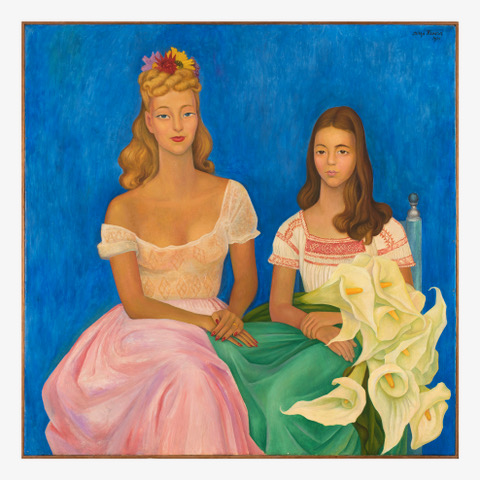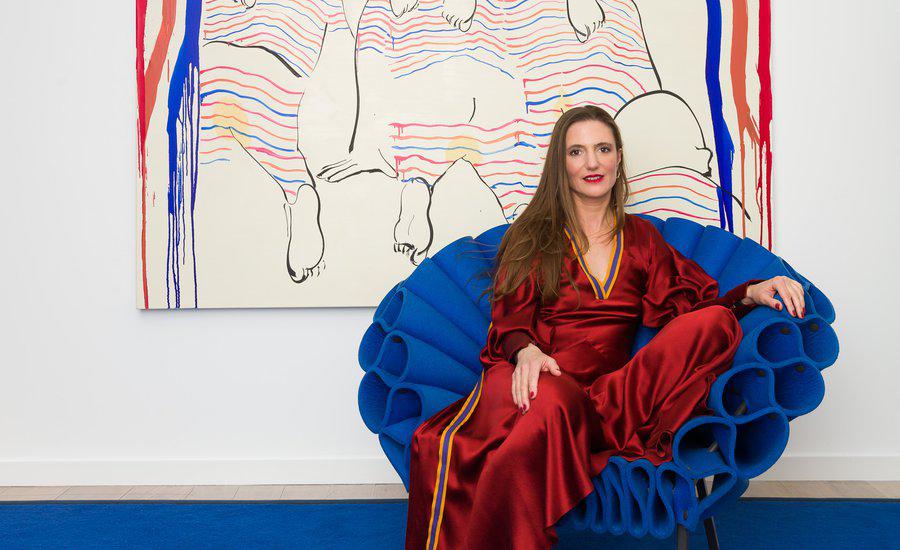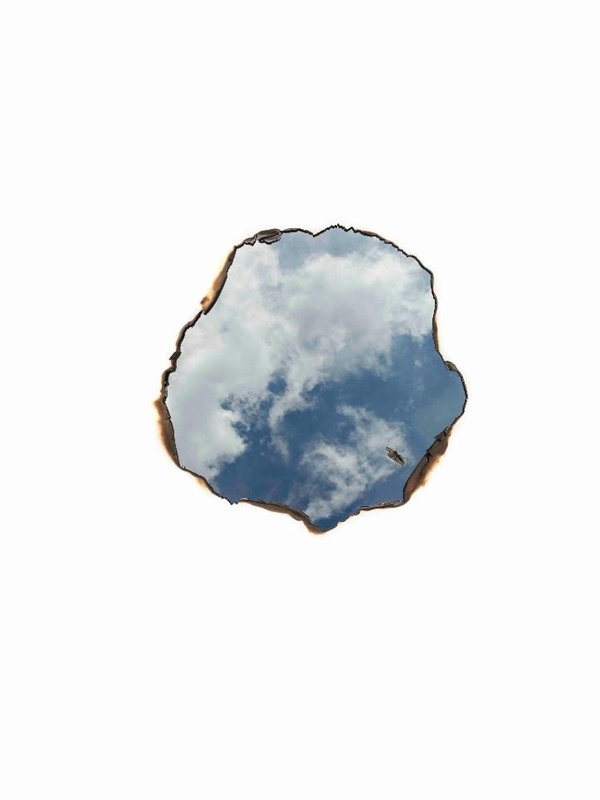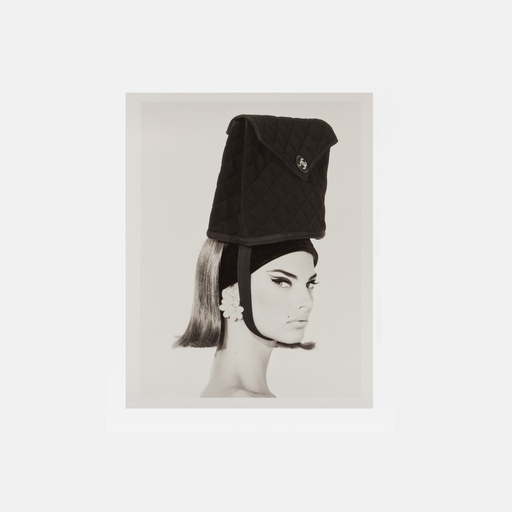Pilar Corrias opened her first gallery on Eastcastle Street in central London back in 2008, though really she could have settled almost anywhere. “The gallery has a very international programme and I think that is to do with how I’ve been brought up,” she explains.
Corrias, who represents Christina Quarles , Rachel Rose , Tala Madani and Tschabalala Self , among others, is the daughter of a diplomat and a painter, and led a highly cultured, peripatetic life prior to settling in the British capital. “My parents were living in Tokyo when I was born in 1969,” she says. “We lived there for the first two years of my life; then we moved to Rome and then to Lisbon, right after the Carnation revolution. We arrived as the tanks were still in the streets.
"We moved around the world a lot when I was a child and I changed schools about 12 or 13 times. My brother and I spent a lot of time on our own and so drawing and painting was something we did all the time. We used to scribble everywhere - places where it wouldn’t be noticed so that we wouldn’t get caught! Underneath the tops of tables and underneath beds. It was just scribbling - pure freedom, and it represented a place of safety.”
Her mother offered Pilar some advice. “My mother painted watercolors and had exhibitions when she was young,” the gallerist explains. “The most important thing she told me was that whatever mark I made on the paper it didn’t matter. It was OK. It didn’t need to look like anything; and that gave me an immense sense of freedom.”
That sense of freedom helped a little, on family road trips. “We used to drive from Lisbon to Italy every summer, we did that 17 times by car so that’s a lot of hours in the car,” she recalls. “We drew and we had one of these little record players with those little 45s, and my brother and I used to listen to stories on those and fight in the back of the car.”
“After Lisbon we moved to Luanda, Angola, during the civil war between the MPLA and the UNITA with South Africa. (The political situation was very much connected to the Cold War and at a young age this experience gave me understanding of politics, power and oppression). After Angola we moved to Rome and then New York in 1986,” she goes on. “After living in so many places by the age of 18 it definitely marks you.”
Yet what kind of impression does it leave on your art collection? In this interview, Corrias describes her earliest purchases, the art she grew up around, and how her professional life has influenced her private trove of works.
 Diego Rivera, Portrait of Frances Ford Seymour and Frances De Villers Brokaw , (1941)
Diego Rivera, Portrait of Frances Ford Seymour and Frances De Villers Brokaw , (1941)
The art on the walls of her childhood home My parents weren’t collectors but in Japan there was a work on paper by Yoshishige Saito, it was an abstract painting which was red and blue and yellow and white except for this one shape in the middle. My great grandfather collected 19th-century Italian art. I remember portraits, sort of scenes and Madonnas. I always had trouble with the Madonnas though, and this idea of the pure woman. And especially so in churches. Maybe that’s the early beginnings of me becoming a real feminist.
I found the Japanese artist Saito more interesting. It was abstract and so it went back to the idea that things didn’t need to look like things. My mother also had a Liber Studiorum, a collection of prints by Turner.
And then we had this very beautiful painting by Diego Rivera in the house, a very beautiful portrait of my grandmother and my mother. My mother is holding a big bunch of Calla lilies and my grandmother is looking very… she took her own life before my mother was 17 – but she’s looking very sexy and extremely glamorous and very blonde and my grandmother is sitting next to her with straight brown hair looking very serious. Not the same, not with painted red nails or looking sexy. And it was this contrast between this daughter and mother with these flowers and the colors are extremely bright. I was aware of being number three in that line.
It's in my father’s house and it’s going on exhibition to the San Francisco Museum of Modern Art to a big Rivera exhibition next year. It’s never been seen in public before.
My mother used to tell me stories about sitting for Diego Rivera, how he always used to have a pistol with a mother of pearl handle in his pocket because he was a communist and friend of Trotsky and he was scared of being assassinated. She remembers meeting Frida Kahlo and there were white doves on the ceiling of his studio in Mexico City. All those things had quite a strong influence on me and I think they still do now.
 Diego Velazquez, Las Meninas (1656)
Diego Velazquez, Las Meninas (1656)
The first show that blew her mind The first museum I remember going to was the Calouste Gulbenkian Foundation in Lisbon. It was very modern with quite dark rooms containing Roman statues - things that were spot lit - and it felt like a very special place.
I remember going to the Prado when I was about seven-years-old and visiting that room where there's the Spanish royal family and Las Meninas , by Velázquez. I have this memory of the guy with the big nose - Philip IV of Spain I think it was. I remember his face was just so extraordinary and the clothes of the infanta and these portraits of single women of the family. And they had these big dresses. That whole room had a big impact on me - the sheer size of the room and looking at these people from the past and sort of finding them almost as if they were caricatures but at the same time completely fascinating. It really struck me that they were real people that had once existed. I have this really vivid impression of it.
I remember the Azulejo tiles in Sintra, Lisbon, all the blue and white tiles everywhere. And Sintra, it’s not an art museum, but as a child it felt really mysterious and magical as though fairies could be there.
I remember going to the Alhambra and seeing the tiles that decorated it and going to the cathedral in Zaragoza, Our Lady of the Pillar, where there is the column that so many people had touched it was really indented. Those are the things I saw of the outside world. From seeing the tiles at the Alhambra to seeing these Japanese prints to seeing abstract works on the wall to then seeing portraits by Mexican artists and 19th century Italian painting it was really a lot to take from.
I still have this thing now that I can look at a painting and I jump right into it so I take myself there. But you can also get that with books. I remember having a book on Brueghel and spending hours with it. It’s probably the reason why I got into art was because I was bored; I was left with nothing to do. Hours and hours and days on end. There was no internet, nothing else! Art felt like a safe place and even when I went on to study art it took me a while to discover the world I’m in now but when I found it it was like this is it I have found my group of people I want to be with.
I went to art school but I had a lot of issues with my tutors there. When I went on to study history of art at Columbia University I discovered that there was a thing called theory and that it was actually fine to make all the art I’d made at art school the way I wanted to make it and that I didn’t have to deal with angst! That was what they used to tell me, your artwork doesn’t have enough angst and expression! And I was like; well does it really have to have that? I’m not a German male painter! From there I discovered conceptual art and did a masters in art theory. I loved that it wasn’t just about painting.
 Douglas Gordon
, Chambre , 1993, matt blue (Pantone 2935U) / vinyl, accompanied by certificate
. Variable Dimensions. Courtesy of the artist and Pilar Corrias, London. Photography: Mark Blower.
Douglas Gordon
, Chambre , 1993, matt blue (Pantone 2935U) / vinyl, accompanied by certificate
. Variable Dimensions. Courtesy of the artist and Pilar Corrias, London. Photography: Mark Blower.
The first piece of art she bought The first piece of art I bought was by Douglas Gordon , a very early text work called Chambre , from 1993. But I only installed it for the first time a couple of months ago. It’s a text work that he made for one of Hans Ulrich’s first exhibitions. The first one he did was in a kitchen and the second one he did was in a hotel in Paris. This artwork was installed in the hotel. It’s meant to be installed above a window and it reads: ‘From this moment until the next time.’ I thought it was a lovely thought. So you look out the window and you look at Paris and I thought that was very poetic. I’m moving house soon and I’m hoping to install it above my window.
We dealers travel a lot so I can relate to this a lot. ‘I’m going but I’m coming back.’ Douglas and I are still friends. He was one of the first artists I worked with and is of my generation of artists who I started to engage with when I first started to work.
The piece that got away I don’t think there is one. I think that the most important thing I can do as a gallerist is collect my own artists. I work with them closely. I have either discovered or have been the first important gallery they’ve shown with so the relationships we have are very close. I feel it’s important to own their work. And if all this work went through my hands and I had nothing to show at the end for it it would be a very sad thing. I regret not being able to do that at the beginning but survival was more important then! But I like to support my own artists first and foremost, so I live with the work of the artists I work with.
The collection changes as my life changes. I’ll have an early work by an artist and their work changes as my gallery changes. The way I collect is very much like a life journey and it’s something I feel is very important to do. I just balance it as fairly as possible as I can. I always tell the artist this is the work I’d like to get and if they’re opposed they’ll tell me. I don’t have to hide the fact I have an open relationship with them.
 Tala Madani
, Piss Smiley, 2011.
Oil on linen
. 76.2 x 101.6 cm. Courtesy of the artist and Pilar Corrias, London
Tala Madani
, Piss Smiley, 2011.
Oil on linen
. 76.2 x 101.6 cm. Courtesy of the artist and Pilar Corrias, London
The piece everyone comments on I don’t know. I think there is one work that my son has – there are actually two works, by Tala Madani . But there’s one work in particular called Piss Smiley . It’s these men that are being pissed on and their heads are covered in piss. My son has had it in his bedroom ever since he was about five. He was recently on zoom on one of his online seminars and he just didn’t want that painting to be seen in the background (he’s studying art history at Cambridge) I think he didn’t want to be asked about it! They are smiling but they’re covered in piss. And then I have a big one in my living room called Piss Rainbow and it’s these men on all fours and Tala has placed yellow oil on their butts. So everyone always comments on the fact that they have dirty butts. I always end up having to explain Tala’s work to people and that it’s a critique of masculinity, and that these men are messy and regressive and unmacho like.
 Tala Madani
, Piss Rainbow , 2008,
Oil on linen,
210 x 195 cm
82 5/8 x 76 3/4 in. Courtesy of the artist and Pilar Corrias, London
Tala Madani
, Piss Rainbow , 2008,
Oil on linen,
210 x 195 cm
82 5/8 x 76 3/4 in. Courtesy of the artist and Pilar Corrias, London
The artwork in the bedroom I have a small watercolor by my mother and a little drawing by Ian Cheng - one of the artists I work with - next to my bed. But there isn’t the right space, it’s not big enough or the right space or I don’t feel that I have the right work for my bedroom.
What someone might deduce about her from her collection That I’m really close to the artists I work with and that I support them. I don’t have a pattern or set way of doing things. Sometimes I’ll buy an artist’s work and not represent them. Sometimes I’ll buy the work later or before. It depends on whether there's a work available for me to buy. And it just depends on the situation. Yeah, I obviously buy work that I love and I only work with artists that I love too. I own works that I don’t live with. Video works for example and the Douglas Gordon work I’m only installing after 25 years. So I don’t necessarily feel the need to put it in my house if I own it.
The thing that’s not art, but is to her Maybe the table I’m sitting on. It’s a table made by Rirkrit Tiravanija . And it’s a dining table with chairs and benches and it’s a piece of furniture he made in Thailand. He’s a very well-known artist but he sometimes makes furniture. He also cooks and does cooking performances, so to have a dining table by him is quite special. It’s not like Franz West who makes tables and chairs. I think it’s a semi artwork. It’s not an artwork but it is. It’s a quasi-object, a work that becomes an artwork when it gets activated.
 Shara Hughes
, Soft and Strong , 2021
Oil and acrylic on canvas
. 243.8 x 182.9 cm
96 x 72 in. Courtesy of the artist and Pilar Corrias, London. Photography: Stan Narten
Shara Hughes
, Soft and Strong , 2021
Oil and acrylic on canvas
. 243.8 x 182.9 cm
96 x 72 in. Courtesy of the artist and Pilar Corrias, London. Photography: Stan Narten
The piece that reflects where she is now There are three women painters who I represent who’ve made works in the last year that make me think about different aspects of myself and the world around me.
One is a painting by Shara Hughes and it’s called Soft and Strong . It’s really new, it’s never been seen. It’s going to be on view at the Garden Museum, London this month. It’s a painting of a dandelion and there are lots of nettles around the dandelion. And to me it represents what it means to be an art dealer. In that you have to have an extreme sensitivity towards art and you have to be extremely perceptive and open to the meaning of things and then at the same time but you also have to be extremely tough when you are dealing with competition and dealing with the market. You’re dealing with financial issues and people fighting; aggressive hard-nosed business situations. It’s a particular kind of job that I have. It doesn’t always marry super well. So when she showed me that work I thought it really feels like what I do and the situations I encounter and how I have to deal with them.
There is a new work on view at the Baltimore Museum. It’s called Two Women 3 by Tschabalala Self . And it’s these two women who, in my eyes, are gossiping or having a real chat, and perhaps sharing secrets; and it just made me miss those social situations that I really crave. Even with Tschabalala herself - just having a good time together. And hanging out with a friend and chatting. So I really identify with that painting.
 Tschabalala Self
, Two Women 3 , 2021
. Tulle, lace, velvet, thread, acrylic paint, digital print on canvas, and painted canvas on canvas
. 243.84 x 243.84 cm
96 x 96 in.
Courtesy of the artist and Pilar Corrias, London. Photography: Christopher Burke.
Tschabalala Self
, Two Women 3 , 2021
. Tulle, lace, velvet, thread, acrylic paint, digital print on canvas, and painted canvas on canvas
. 243.84 x 243.84 cm
96 x 96 in.
Courtesy of the artist and Pilar Corrias, London. Photography: Christopher Burke.
There’s another artist I represent Christina Quarles , she made a painting called Edge of Tomorrow . She painted it when there were the fires in California and you couldn’t see the sun and the sky was hazy. Her work is about the ambiguity of gender. Our identity has a lot of slippages whoever we are. But there is an orange sun in this one and I feel that the work touches on global warming and we’re in a moment where we are wondering about the future and where things are heading. This painting touches on things that are on the outside that I’m thinking about. What is the next pandemic going to be? Are we going to be living online forever? Are the identities we form online going to be different from the identities we form in real life?
 Christina Quarles
, Edge of Tomorrow , 2020
. Acrylic on canvas
. 182.9 x 152.4 x 5.1 cm
72 x 60 x 2 in
. Courtesy of the artist and Pilar Corrias, London. Photography: Mark Blowe
Christina Quarles
, Edge of Tomorrow , 2020
. Acrylic on canvas
. 182.9 x 152.4 x 5.1 cm
72 x 60 x 2 in
. Courtesy of the artist and Pilar Corrias, London. Photography: Mark Blowe
The artwork you would love to have Maybe Artemisia Gentileschi’s Judith Slaying Holofernes , because it’s such an incredible painting by a woman. It’s such an incredible feminist painting and as women we need women artists as examples to look up to and think I can become that. This anger, this idea of revenge - a painting like that still has meaning. She’s really one of the first examples of a great master that we know of. Plus she’s Italian and I’m half-Italian and half-American.
The person who shares her taste in art My children. One is studying philosophy and one studying art history. They like the artists I represent. My boyfriend is an art dealer and he partially shares my taste. He doesn’t like all of it. My sons always comment on the work.
The artwork she’ll leave to someone she loves Oh my god that’s really difficult. I would definitely try not to sell that Diego Rivera. I will never sell it so I think that will definitely have to go to somebody I love.
 Pilar Corrias, photograph by Mark Blower
Pilar Corrias, photograph by Mark Blower





























